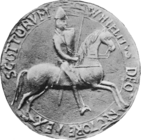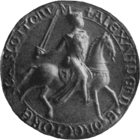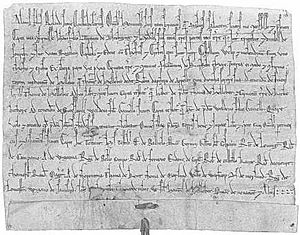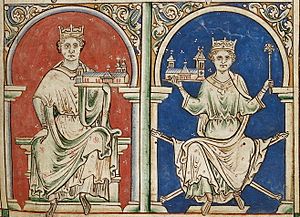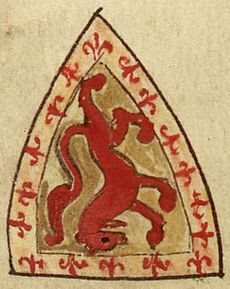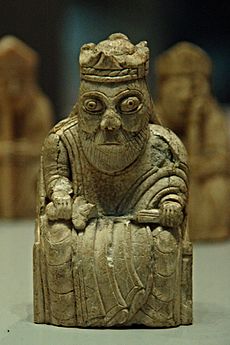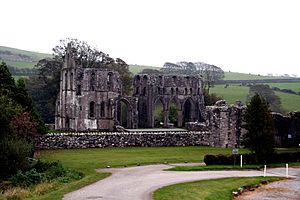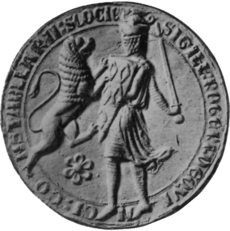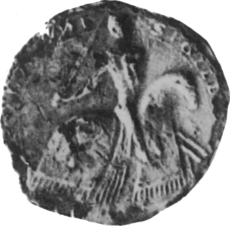Alan of Galloway facts for kids
Quick facts for kids Alan son of Roland |
|
|---|---|
| Lord of Galloway | |
Alan's name as it appears on folio 65r of Oxford Bodleian Library Rawlinson B 489 (the Annals of Ulster).
|
|
| Reign | 1200–1234 |
| Predecessor | Roland (Lochlann) of Galloway |
| Born | before 1199 |
| Died | 1234 |
| Burial | Dundrennan Abbey |
| Wives |
|
| Issue | unnamed; Helen; Christiana; Dervorguilla; Thomas; Thomas |
| Father | Roland (Lochlann) of Galloway |
| Mother | Helen de Morville |
Alan of Galloway (born before 1199 – died 1234) was a very important Scottish leader in the 1200s. He was the hereditary Lord of Galloway and the Constable of Scotland. This made him one of the most powerful people in the Kingdom of Scotland and around the Irish Sea.
Alan became a lord around 1200, when he took over his father's lands and titles. Later, he also inherited his mother's lands, making him even more powerful. Alan also owned land in England and advised King John on the Magna Carta. He helped King Alexander II of Scotland with his plans in northern England.
Alan also took part in England's efforts to settle Ulster (part of Ireland). He received a huge amount of land there from the English king. At the same time, he helped the Scottish king fight against rebels in western and northern Scotland. Alan also got involved in a big family fight for control of the Kingdom of the Isles. He supported one relative against another. Alan's actions in the Isles, which were under Norway's control, made King Hákon of Norway very angry. This caused a serious problem for the Scottish king.
As the ruler of the semi-independent Lordship of Galloway, Alan was important to both the Scottish and English kings because of his strong army. Norse stories even called him one of the greatest warriors of his time. Like his family, he was very generous to religious groups. Alan died in February 1234. In Galloway, an illegitimate son could usually inherit. But under Scottish law, Alan's daughters were his rightful heirs. King Alexander used Alan's death to bring Galloway more under his control. He divided the lordship among Alan's daughters. Alan was the last ruler of Galloway from the original family line of Fergus, Lord of Galloway.
Contents
Who Was Alan of Galloway?
Alan's Family and Early Life
Alan was born before 1199. He was the oldest son of Roland, Lord of Galloway, and Helen de Morville. His parents likely married before 1185. Roland had to give three sons as hostages to King Henry II in 1186. This shows how important his family was.
Alan had two brothers and two sisters. One brother, Thomas, later became the Earl of Atholl. His sister Ada married Walter Bisset. His other sister, Dervorguilla, married Nicholas de Stuteville.
Alan's mother, Helen, was the daughter of Richard de Morville. Richard was an Anglo-Norman lord and Constable of Scotland. Alan's father, Roland, was the son of Uhtred, who was the son of Fergus. Fergus was the first known Lord of Galloway.
Important Family Connections
Fergus's daughter, Affraic, married Amlaíb mac Gofraid, King of the Isles. This marriage was very important. It meant Alan was related by blood to the kings of England and the kings of the Isles. These connections played a big role in Alan's life and career.
| Simplified family tree of Alan illustrating his degree of kinship with the contemporary kings of England and the Isles. | |||||||||||||||||||||||||||||||||||||||||||||||||||||||||||||||||||||||||||||||||||||||||||||||||||||||||||||||||||||||||||||||||||||||||||||||||||||||||||||||||||||||||||||||||||||||||||||||||||||||||||||||||||||||||||||||||||||||||||||||||||||||||||||||||||||||||||||||||||||||||||||||||||||||||||||||||||||||||||||||||||||||
|---|---|---|---|---|---|---|---|---|---|---|---|---|---|---|---|---|---|---|---|---|---|---|---|---|---|---|---|---|---|---|---|---|---|---|---|---|---|---|---|---|---|---|---|---|---|---|---|---|---|---|---|---|---|---|---|---|---|---|---|---|---|---|---|---|---|---|---|---|---|---|---|---|---|---|---|---|---|---|---|---|---|---|---|---|---|---|---|---|---|---|---|---|---|---|---|---|---|---|---|---|---|---|---|---|---|---|---|---|---|---|---|---|---|---|---|---|---|---|---|---|---|---|---|---|---|---|---|---|---|---|---|---|---|---|---|---|---|---|---|---|---|---|---|---|---|---|---|---|---|---|---|---|---|---|---|---|---|---|---|---|---|---|---|---|---|---|---|---|---|---|---|---|---|---|---|---|---|---|---|---|---|---|---|---|---|---|---|---|---|---|---|---|---|---|---|---|---|---|---|---|---|---|---|---|---|---|---|---|---|---|---|---|---|---|---|---|---|---|---|---|---|---|---|---|---|---|---|---|---|---|---|---|---|---|---|---|---|---|---|---|---|---|---|---|---|---|---|---|---|---|---|---|---|---|---|---|---|---|---|---|---|---|---|---|---|---|---|---|---|---|---|---|---|---|---|---|---|---|---|---|---|---|---|---|---|---|---|---|---|---|---|---|---|---|---|---|---|---|---|---|---|---|---|---|---|---|---|---|---|---|---|---|---|---|---|---|---|---|---|---|---|---|---|---|---|---|---|
|
|||||||||||||||||||||||||||||||||||||||||||||||||||||||||||||||||||||||||||||||||||||||||||||||||||||||||||||||||||||||||||||||||||||||||||||||||||||||||||||||||||||||||||||||||||||||||||||||||||||||||||||||||||||||||||||||||||||||||||||||||||||||||||||||||||||||||||||||||||||||||||||||||||||||||||||||||||||||||||||||||||||||
Alan's Rise to Power
Becoming Lord of Galloway
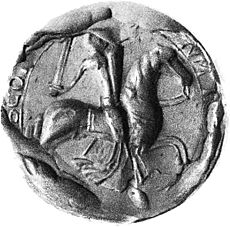
Roland, Alan's father, died in December 1200. Alan then became the Lord of Galloway. He also inherited the title of Constable of Scotland. This was a very important job, passed down from his mother's family. As Constable, Alan was in charge of leading the king's army. This title was so important that he often used it before his title as ruler of Galloway.
Alan was active in the Scottish court even before his father died. He first appeared in records in December 1199, witnessing a royal document. For the next ten years, Alan was often with the Scottish king. His name usually appeared among the top four people listed, showing his high status.
Important Marriages and Influence
Around 1209, Alan married Margaret. She was the niece of the Scottish king and the daughter of David, Earl of Huntingdon. This marriage showed how important Alan was in society. From about 1210 to 1215, Alan became less involved in Scottish affairs. Instead, he spent more time on English matters.
Alan's Ambitions in Ireland
Lands in Ulster
In the early 1200s, Alan received a huge amount of land in Ulster, Ireland, from King John. This likely happened after King John's trip to Ireland in 1210. King John had defeated the powerful Lacy family there. He was able to give their lands to his supporters, like Alan.
Some records suggest Alan received the land in 1210. Others point to 1212. A historian from the 1400s, Walter Bower, said Alan received a lordship of 160 knights' fees. This was a very large amount of land.
Why Ulster Was Important
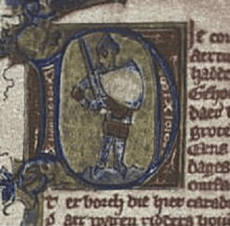
King John and the Scottish king, William, likely worked together on this. In 1211, a rebel group called the Meic Uilleim invaded northern Scotland. They might have been supported by Irish leaders. Giving Alan land in Ulster helped both kings. It secured the borders of Scotland and helped England control Ireland.
Alan's new lands covered much of northern County Antrim and north-eastern County Londonderry. This was a huge area, but it was also a wild region where local Irish power was strong. Alan's brother, Thomas, and his cousin, Donnchad mac Gilla Brigte, Earl of Carrick, also received lands nearby.
Serving Two Kings
Helping King John
In July 1212, King John asked Alan to send 1,000 of his best soldiers from Galloway. These troops were needed for a planned war in northern Wales. The Scottish king, William, likely agreed to this. Alan sent the troops but refused to pay for them. This might have been to show that Galloway did not owe military service to England.
In late 1214, King William died. His son, Alexander II, became king. Alan quickly received royal approval to keep his title as Constable of Scotland.
Magna Carta and Changing Sides
Until 1215, Alan successfully served both the English and Scottish kings. But the political situation in England got worse. King John faced a rebellion from his barons. The Scottish king, Alexander, sided with some of John's enemies.
Alan tried to stay loyal to both kings for a while. But he eventually chose to support King John. In May 1215, the rebel barons turned against King John. John then gave Alan money, showing how much he valued Alan's strong army.
In June, King John was forced to agree to the Magna Carta. This document limited the king's power. Alan was present during these talks and was one of the 27 advisors listed in the document. This shows his influence. The Magna Carta even included a part (clause 59) that required John to address some issues raised by King Alexander.
War with England
When King John later broke his promises in the Magna Carta, King Alexander fought against him. Alan joined Alexander's side. In 1216, the English government called Alan a rebel. Scottish records show that soldiers from Galloway were part of the Scottish army that invaded Northumberland in July 1217.
Alan even granted land in northern England during this war. This showed he was trying to claim territory for Scotland. Although these land gains were temporary, Alan's influence lasted for years.
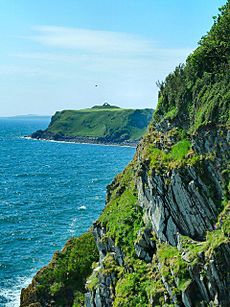
Peace and New Challenges
Reconnecting with England
After the war, it took Alan some time to get back on good terms with the English king, Henry III. Alan's mother died in June 1217, and he inherited more lands in Scotland. This kept him busy.
It wasn't until 1220 that Alan's loyalty to King Henry was settled. His English and Irish lands were confirmed. In April 1220, Alan wrote to Henry, explaining that he and his brother couldn't use their Irish lands. King Henry ordered that Alan's lands be returned. Alan then met King Henry at York in June. He swore loyalty to Henry and received confirmation of his lands. Alan also swore to uphold King Alexander's promise to marry one of Henry's sisters.
Campaigns in Scotland

We don't know much about Alan's activities in the early 1220s. But as Constable, he likely helped King Alexander in his campaigns. One campaign went deep into the Scottish Highlands. Alexander's success helped him establish new lordships in the north.
Alan's brother, Thomas, was also active. He killed a claimant to the kingship of Connacht (in Ireland) in a sea battle. This fight might have been linked to a Scottish attempt to take over Argyll.
Scottish records say that Alan's Gallovidian soldiers were part of Alexander's forces in Argyll. The Scots launched a second, successful attack the next year. This led to the region giving in. King Alexander then built a royal castle at Tarbert and a royal town at Dumbarton.
End of Irish Ambitions
Losing Ground in Ulster
In 1223 and 1224, Hugh de Lacy fought to get his Irish lands back. He allied with Áed Méith, an Irish king, and took over most of Ulster. Records show that Áed Méith destroyed Thomas's castle at Coleraine.
Alan wrote to King Henry in 1224. He said he was about to invade Ireland but heard that Hugh de Lacy had made a deal with the English. Alan asked the king to protect his and his brother's lands if Hugh was restored to power. Although Alan received permission to settle his Irish lands the next year, there is no sign he or his brother ever developed them.
A New Marriage and Lost Hopes
Late in 1225, Thomas received money from the king, likely to make up for his losses in Ulster. Even though the English promised to protect their lands, Hugh de Lacy continued to threaten them until 1227.
In 1229, Alan and Thomas were asked to join an English military campaign in France. Thomas went, but Alan refused. He hadn't received compensation for his troubles in Ireland. It was likely in this same year that Alan married Rose, Hugh de Lacy's daughter. This marriage might have been Alan's last attempt to save his family's interests in Ulster. By then, Hugh controlled the region. Alan's long-held Irish ambitions finally ended.
Trouble in the Isles
Fighting for Control

Alan's efforts in Ireland might have failed because he was also spending a lot of resources in the Kingdom of the Isles. When Gofraid mac Amlaíb, King of the Isles died in 1187, he wanted his younger son, Amlaíb Dub, to be king. But Amlaíb was a child, so the Islesmen chose Gofraid's older, illegitimate son, Ragnall, as king.
As the 1200s continued, the half-brothers began to fight. Alan helped Ragnall against Amlaíb Dub. The Scottish king was worried about this fighting. It could spread into Scotland or be used by rebels. The Scots likely supported Ragnall to bring stability to the region.
Alan's Involvement in the Isles
Around 1225, Alan helped Ragnall in an unsuccessful attack on Amlaíb Dub in the Hebrides. Soon after, Ragnall's daughter married Thomas, Alan's illegitimate son. This marriage seems to have cost Ragnall his kingship. The Manxmen removed him from power and replaced him with Amlaíb Dub. This might have happened because Alan's son was seen as a future ruler, which the Manxmen didn't like.
After losing his throne, Ragnall went to Alan's court in Galloway. In 1228, Alan, Ragnall, and Thomas invaded Mann (an island in the Isles). They devastated the southern part of the island. Alan even put his own officials on Mann to collect tribute for Galloway. But their success was short-lived. Amlaíb Dub returned and defeated the remaining Gallovidian forces.

In January 1229, Ragnall tried to invade Mann again. But he had little support from Galloway. Ragnall was finally defeated and killed in battle by Amlaíb Dub. Alan's lack of support might have been due to a new rebellion in Scotland. As Constable, Alan would have been needed there.

Alan's marriage to Rose de Lacy in 1229 may have also ended Irish support for the Scottish rebels. This helped bring stability to the region.
Facing Norway's King
A Major Crisis in the Isles
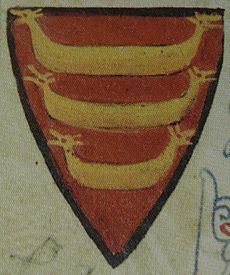
Alan's fight against Amlaíb Dub continued even after Ragnall's death. Reports of the fighting reached King Hákon of Norway, who was the ruler of the Isles. The king's saga (story) said Alan was the "greatest warrior at that time." It also said Alan had a large fleet and plundered the Hebrides.
In early 1230, Amlaíb Dub arrived at King Hákon's court. Alan and his allies had forced him out of the Isles. Some stories say Alan even boasted he could invade Norway. This might have been a trick by Amlaíb Dub to make King Hákon even angrier at Alan.
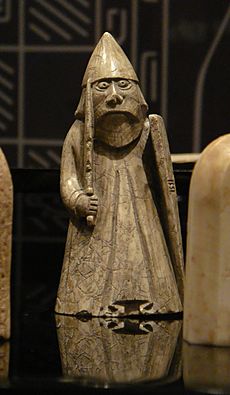
King Hákon had already started preparing for a military campaign in the Isles. He appointed a new King of the Isles, Óspakr, and gave him command of the Norwegian fleet. Óspakr's fleet sailed to the Isles, growing to 80 ships and about 3,000 men.
Showdown in the Clyde
News of the large Norwegian fleet reached King Alexander. He quickly went to the western coast of Scotland. On May 28, Alan was with King Alexander at Ayr, where Scottish forces gathered.
In June, the Norwegian fleet entered the Firth of Clyde. They landed on Bute and captured Rothesay Castle. This castle belonged to the Steward of Scotland, an important Scottish official. Reports that Alan was nearby with a massive fleet forced the Norse to retreat. Alan's fleet was said to have 150 to 200 ships, meaning 2,000 to 3,000 men.

Óspakr died from wounds suffered on Bute. Amlaíb Dub then took command of the fleet. He used it to regain control of Mann. The Norwegians stayed there for the winter and returned home in 1231. Amlaíb Dub then fully controlled the island kingdom.
The events of 1230–1231 ended Alan's ambitions in the Isles. His long fight against Amlaíb Dub had caused a serious international problem. The Norse had attacked Scottish lands, almost leading to a full-scale war. Alan's large fleet had scared them off, but he likely earned King Alexander's disapproval.
Alan's Family and Death
His Wives and Children
Alan was married three times. His first wife was a daughter of Roger de Lacy. Through this marriage, Alan gained the English lordship of Kippax. His second marriage, around 1209, was to Margaret, the daughter of David, Earl of Huntingdon. This connected him to the Scottish royal family. His third marriage, likely in 1229, was to Rose, the daughter of Hugh de Lacy. This connected him to another powerful branch of the Lacy family.

Alan had several children, but only daughters lived to adulthood. His daughter Helen married Roger de Quincy. Christiana married William de Forz. His younger daughter, Dervorguilla, married John de Balliol in 1233. Alan also had a legitimate son named Thomas, who died young, and an illegitimate son, also named Thomas.
Alan's Death and Legacy
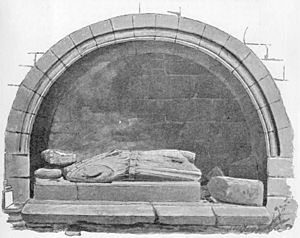
Alan's brother, Thomas, died in 1231. Alan himself died about three years later, in February 1234. He was buried at Dundrennan Abbey, a religious house founded by his great-grandfather. A stone statue there is believed to be his.
Alan was the last ruler of Galloway from his family's original line. His death ended about 50 years of stable rule. He had no legitimate male heir, which caused a big problem for who would rule next.

Alan might have hoped his illegitimate son, Thomas, would take over. Under old Celtic custom, this was allowed. But under Scottish feudal law, Alan's three daughters were his closest heirs. King Alexander saw this as a chance to bring Galloway fully into his kingdom. He divided the lordship among Alan's daughters. The people of Galloway didn't like this and rebelled, but Alexander quickly crushed them.
After Alan's death, the title of Constable passed to Roger de Quincy, his son-in-law. Alan's Irish lands were not inherited by his daughters.
Alan's Importance
A Bridge Between Cultures
Alan was able to move easily between the native Gaelic culture of Galloway and the French-influenced courts of England and Scotland. His father, Roland, also did this. Alan's own name might show this French influence.
Alan's family was known for supporting religious groups. Alan himself gave money to St Andrew's Priory. In 1218, he founded Tongland Abbey in Galloway. In 1220, he went on a pilgrimage to Canterbury with other important lords. They visited the tomb of St Thomas of Canterbury. Alan's ancestors were related to one of Becket's killers, which might explain his religious journey.
Influence and Decline
The events of 1230–1231, when Alan faced the Norwegian fleet, likely hurt his standing with King Alexander. After 1231, Alan's influence decreased. Meanwhile, the power of the royal steward, Walter fitz Alan, grew. Walter was a powerful Scottish lord in the Clyde region. King Alexander seemed to trust Walter more to extend royal power into Argyll.
Alan had amazing military resources. King John asked for 1,000 of his best warriors. Alan's fleet in 1230–1231 was huge, showing his great power.
Images for kids



